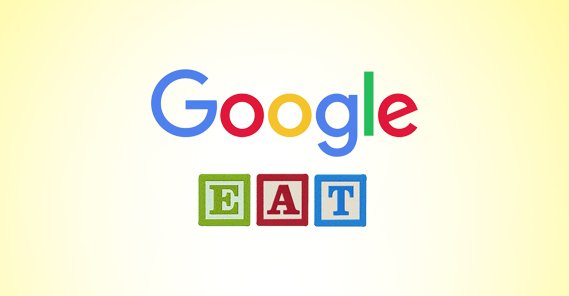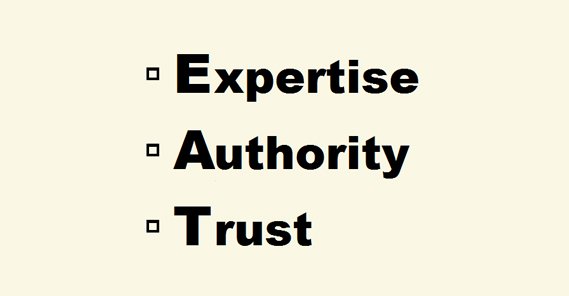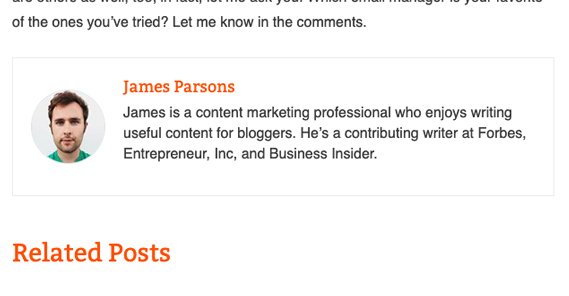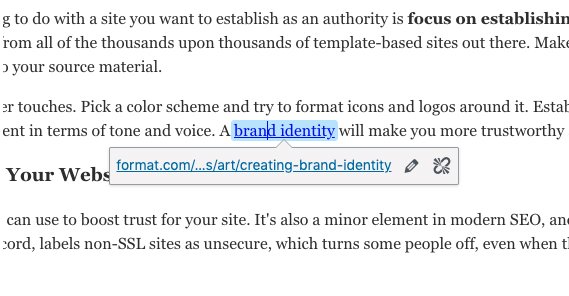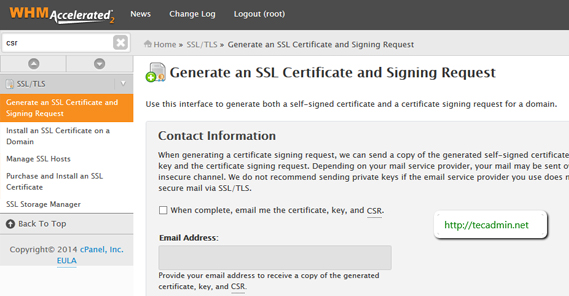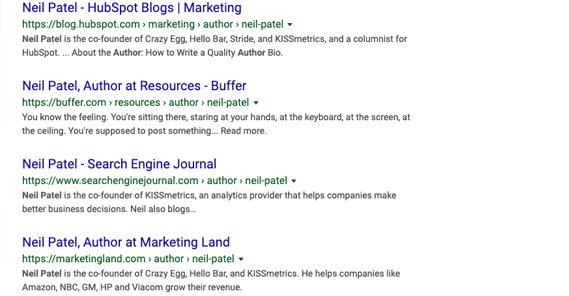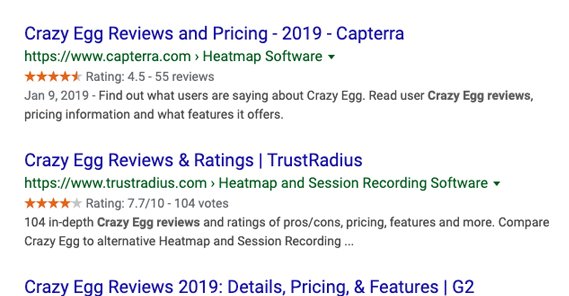15 Ways to Improve Your Blog’s E-A-T Score
Published by James Parsons • Content Marketing • Posted June 2, 2021 ContentPowered.com
ContentPowered.com
As a blogger, you may have heard of something called your EAT score. This score is part of a Google core algorithm update they released back in August of 2018.
If you haven’t heard of EAT before now, there are two plausible reasons. The first is that you simply missed the news. The second is that you’re not part of the industries that it targets.
EAT is part of an algorithm update that focuses primarily on health and wellness website, but also impacts legal and finance websites. Websites outside of those industries aren’t as likely to be affected by EAT changes. These industries are known as YMYL: Your Money, Your Life. In other words, any industry or website that encourages you to follow their advice regarding either your money or your life is a site where the EAT score applies.
Of course, as with any Google update, complying with it now can help improve your site. Either Google has added it as part of their general updates, with a stronger emphasis for those industries, or they’re simply factors that will apply to any site.
So what is E-A-T, and how can you improve it?
What Is E-A-T?
EAT is an acronym. It’s made up of three words, each detailing a concept Google has decided is important for sites in those specific niches.
They are:
Expertise. The information presented on a page should come from an expert in their field. If you’re an expert, you can cite your own credentials to establish your level of expertise. If you’re not an expert, you should get your information from an expert source, and cite the source with their credentials to prove that it’s valuable information. This part of EAT is meant to help minimize the number of unfounded “experts” and gurus and other people who simply want to exploit an industry for a quick buck.
Authority. The information presented on a page should come from a source of authority. Who are you to be writing about it? If you’re not an expert, you should at least be someone with some level of authority, such as an author who has continually written about a given subject for years. Typically, this involves including writer credentials in blog posts.
Trust. Users need to be able to trust the information they get on a page. You want to build in signs of trust so that your users will be able to trust your authors, your website, and your content.
As you can see, all three of these qualities are basically just different aspects of the same thing. Google wants the content you find through their search to be high quality, trustworthy, and authoritative. These qualities are extra important in areas like finance or health, where following the wrong advice can lead to severe personal consequences, like bankruptcy or hospitalization.
In the title, I promised 15 ways to improve your blog’s EAT score. Here are those 15 ways.
1. Add an Author Byline to Every Post
One of the core elements of trust on a website is knowing who is writing the content you’re reading. As a blogger, you should have an author name and byline at the top of each post, and a longer author bio at the bottom of every post. It’s easy enough to set these up that it should be no problem to maintain, even if you have authors who come and go.
One thing you should avoid doing is having every post published by “site admin” or by another generic name. These sites seem like they’re trying to hide who is really behind them, and that does nothing to inspire trust in your readers. A publicly visible author is a more trustworthy author.
Depending on your blog platform, this may be something that you can add with a plugin, or it may be something that you have to hard code into your template.
2. Maintain an About Section to Explain Who You Are
A good blog should have an About section to explain who you are. This is relevant for single-author blogs because it gives you a long-form location to explain your background, your inspiration, and what makes you trustworthy. You see these all the time on travel websites, for example.
On a multi-author blog, your About section can serve to explain to the reader who you are to bring these people together, what your authority is, and what the goal of your site is. Obviously, even if your goal is “to make money”, you want to showcase your concern for your readers and your industry at large.
3. Link to Authoritative Sources for Information
Whenever you cite a piece of information, ideally you should cite a source for that information. Sometimes it can be as simple as a link to Wikipedia for something foundational. If it’s something that comes from a study or a survey, link to the original source of that data. If it’s a survey you published yourself, link to the long-form source of the data so that people can see the actual data you’re using.
The goal here is to make yourself part of something larger than yourself. People might not trust you, but if you’re getting your information from somewhere else, they’re more likely to trust you for referencing it, assuming it’s a good source. They can also use that source to judge you if, for example, you’re linking to a source known to be untrustworthy.
4. Explain Source Credentials in Your Text
You don’t have to do this for every single piece of information, but when you have a crucial piece of information to build upon in your post, you should explain the source in greater detail than just a link. Instead of “according to X”, you can write “According to X, leader of the Y foundation, in their study about Z”.
Of course, this will get long and overly complex if you do it for everything. I generally prefer to leave this level of detail to the most crucial pieces of information or for people who may not be known. The more prominent and recognizable a figure is, the less information you’ll need to write about who they are.
5. Focus on Establishing a Trustworthy Brand Identity
Perhaps the number one thing to do with a site you want to establish as an authority is focus on establishing a brand. Make a logo for yourself. Make a custom blog theme so you stand out from all of the thousands upon thousands of template-based sites out there. Make sure your content is as unique as possible, while still being relevant and accurate to your source material.
You can also delve into smaller touches. Pick a color scheme and try to format icons and logos around it. Establish a graphical style for your images. Make sure the writing on your site is consistent in terms of tone and voice. A brand identity will make you more trustworthy as more and more people read you over time.
6. Implement SSL for Your Website
SSL is a security method you can use to boost trust for your site. It’s also a minor element in modern SEO, and it helps users of browsers like Chrome trust your site more. Chrome, for the record, labels non-SSL sites as unsecure, which turns some people off, even when the content is simply a blog post and doesn’t really need security.
Implementing SSL properly can be tricky, but once you establish it, you’re good to go for the foreseeable future. It’s a good change to make, and doubly so if you have anything where a user needs to log in or submit information to your site.
7. Use Relevant Trust Badges Where Necessary
Tasteful use of a couple of trust badges can go a long way towards establishing trust for a new site. This is most important if you have a storefront and you want to establish that your checkout process is secure.
Keep in mind that using too many different trust seals all at once looks trashy and fake. Pick a couple of the most relevant trust badges and use them, don’t just use every one you can find.
8. Build Your Site Larger
I don’t mean taller or wider, here; I mean deeper. Add more pages. Add more content. Buff up the back catalog until you have a ton of content for users to go through.
They won’t, but Google will. Google can tell when you have a lot of content, and they’ll be able to roughly analyze that content for other EAT signs. The more good, authoritative, trustworthy content you have on your site, the more credit Google will give you.
To a certain extent, this takes time. You can’t go from nothing to a site with 10,000 articles on it overnight and not draw some suspicion. You need to build up your site over time to build that authority.
9. Focus on High Quality Backlinks
It should come as no surprise that backlinks are a huge sign of trust. Getting good links from good sources will boost trust in your site, and that has innumerable benefits with Google’s algorithm.
10. Write for Other Sites in Your Industry
One way to get more backlinks, and build more trust in yourself as an author, is to write for other sites in your niche. The better the site, the more trust you establish in writing for it, because if you’re not a trustworthy or relevant person, why would they let you write for the site?
This is a core element to blog outreach and guest posting. Reach out to sites that are relevant to your topic and pitch content you can write for them. If they don’t accept you, you may have to start a little lower on the ladder, at lower quality sites, to build up some citations and prove that you can write quality content for sites you don’t own. Eventually, build up to the big names.
11. Cut or Improve Content with Low EAT Attributes
For larger, older sites, it’s worthwhile to go back and look into older content and audit it for its EAT score. Old content that isn’t very long, or that is no longer accurate, or that cites irrelevant information, or that does not cite sources for its information, may be worth removing from your site. That kind of content may be holding you back. If the content is good enough to be worth improving, you can update it and make the information more relevant, with citations, to get that added benefit from it.
12. Fact-Check, Edit, and Include New Information
From time to time, science – or whatever authority governs your niche – discovers something new. It might be a new marketing technique, or it might be a new benefit of a health food, or it might be a new medical breakthrough.
Occasionally, this new information invalidates old articles you have written. It can be a good idea to go back to your old content and edit it to include or reflect this new information. This puts your site ahead of the curve and removes now-false information that can be diminishing public trust in your site.
13. Check Your Website’s Reviews and Ratings
One thing it’s worth doing from time to time is looking up reviews, citations, and ratings for your website. There are a lot of sites out there that serve as review aggregators, and they rate and review other websites.
If your site has negative reviews, or if people have called out your brand as a negative brand in articles, you can try to take action to rectify the situation. In some cases, that means adding positive reviews to outweigh the negative reviews. In others, it might mean refuting the points and getting negative reviews removed.
14. Work to Manage Your Reputation
To carry on from the previous point, it’s worthwhile to occasionally embark on a quest of reputation management. Whether you do it yourself or hire a company to handle it, you want to make sure you’re getting the best possible public image you can, reflective of your actual trust and authority.
15. Keep the User’s Needs First
Above all, you want to make sure you’re keeping the user in mind ahead of your own needs. Especially in the YMYL industries, the user is putting a lot of faith in you, and if you betray that faith, it can be devastating.
